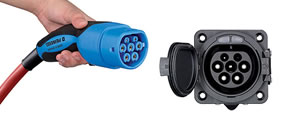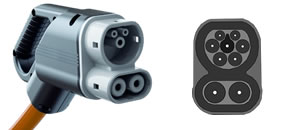
AC Charging
Charge port
Type 2
Max. AC power output
11 kW
Charging time
8h

DC Charging
Charge port
CCS
Max. AC power output
233 kW
Charging time
16m
Find key electric car specifications including range, charging time, price, and the ideal charging station.
The Hyundai IONIQ is an electric mid sized family CUV hatchback available with rear or all-wheel drive. It has a stylish retro-modern design, great onboard tech, and practical range and charging speeds.
77.4 kWh
481 km
€ 60.995
179 Wh/km
5
Yes

Charge port
Type 2
Max. AC power output
11 kW
Charging time
8h

Charge port
CCS
Max. AC power output
233 kW
Charging time
16m
Charging type
Wall plug (2.3 kW)
Time (empty to full)
38h
Range per hour of charging
13 km/h
Our recommendation
This charging method is for emergencies only.
Charging type
1-phase 16A (3.7 kW)
Time (empty to full)
23h 45m
Range per hour of charging
20 km/h
Our recommendation
This charging station takes longer to fully charge this car.
Charging type
1-phase 32A (7.4 kW)
Time (empty to full)
11h 45m
Range per hour of charging
41 km/h
Our recommendation
This charging station takes longer to fully charge this car.
Charging type
3-phase 16A (11 kW)
Time (empty to full)
8h
Range per hour of charging
60 km/h
Our recommendation
This charging station is the best fit for this car!
This charging station will enable you to charge this car at the maximum possible charging speed.
Charging type
3-phase 32A (22 kW)
Time (empty to full)
8h
Range per hour of charging
60 km/h
Our recommendation
This charging capacity is higher than your car can handle.
Read our comprehensive guide to discover everything you need to know about electric vehicle charging before buying an electric car.
The time it takes to charge the Hyundai IONIQ 5 varies based on which version of the IONIQ 5 you purchase, its battery size, and whether you are charging at an AC charging station or DC fast charging station.
For the standard range* versions of the IONIQ 5, with a 54 kWh usable battery capacity, the charging time will be approximately 6 hours from 0 to 100 at the maximum power of 11 kW. As for DC fast charging at the maximum power of 175 kW, it takes approximately 17 minutes to charge from 10 to 80 percent.
For the long-range* versions of the IONIQ 5, with a 70 kWh usable battery capacity, charging from 0 to 100 using an AC charger at a maximum power of 11 kW will take approximately 7 hours and 30 minutes. Using a DC fast charger, on the other hand, will charge your IONIQ 5 in 17 minutes at a maximum power of 221 kW.
*Depending on your location, model names may differ.
The Hyundai IONIQ 5 is currently available in four models* each with a different range:
*Depending on your location. Model names may differ.
**These estimates are based on the WLTP ratings and the actual range may vary based on factors such as speed, weather conditions, and elevation change.
Depending on which version of the Hyundai IONIQ 5 you choose and your location or dealership, the starting price ranges between £39,400 and £48,400* in the UK.
*Prices are taken from Hyundai UK.
The IONIQ 5 is Hyundai’s first all-electric vehicle built from the ground up using their new Electric-Global Modular Platform (E-GMP). What does this mean you may ask? According to Hyundai, this enables a multitude of EV-specific features.
The first of these features relates to convenience, with the ability to charge any device up to 3.6 kW using Vehicle-to-Load (V2L) technology from both inside and outside the vehicle. The Hyundai IONIQ 5 also impresses with its maximum charging rate of 350 kW, charging from 10% to 80% in just 18 minutes. Plus, the interior design provides plenty of space for passengers with two automatic fully reclining front seats for added comfort while you charge.
As for the other features, the Hyundai IONIQ 5 also boasts Level 2 autonomous safety technology that can control speed and distance, assists you in changing lanes, as well as provide collision avoidance assistance and remote parking assistance.
Categorised as a medium five-seater SUV, the Hyundai IONIQ 5 has a length of 4,635 mm, a width of 1,890 mm (2,152 mm including mirrors), and a height of 1,605 mm. The cargo load of the Hyundai IONIQ 5 is 531 litres, with a 57-litre front trunk and a roof load of 80 kg. Altogether, the maximum cargo load is 1,591 litres.
As for the gross vehicle weight (GVWR), the IONIQ 5 comes in at 2,370kg with a maximum payload of 540 kg.
The amount you pay to charge the Hyundai IONIQ 5 is dependent on which version of the IONIQ 5 you are charging and which type of charging station you are using, be this a home charger, public charger, or DC fast charger. We have displayed approximate charging prices in the table below.
Charging station type (right) Hyundai IONIQ 5 version (below) | Home (AC) cost per kWh: £0.28 | Public (AC) cost per kWh: £0.34 | Fast (DC) cost per kWh: £0.54 |
Standard Range* (54 kWh) | £15.12 | £18.36 | £20.41 |
Long Range* (70 kWh) | £19.60 | £23.80 | £26.46 |
Important: Prices are approximations based on our experience and do not represent the real-life situation and represent the cost to charge from zero to 100 percent SoC for AC and from 10 to 80 percent for DC.